Nonlinear Performance of Steel Tube Tower in Ultra-High Voltage Transmission Lines under Wind Loads
Abstract
1. Introduction
2. Establishment and Validation of FE Model
2.1. Establishment of FE Model
2.2. Comparison between FEM and Experiments
3. Structural Capacity Analysis of the Tower
4. Analysis of Influent Factors on Secondary Stress
5. Conclusions
Author Contributions
Funding
Data Availability Statement
Conflicts of Interest
References
- Li, M.H.; Yang, J.B.; Li, Z.L. Analysis on secondary stress for steel-tube tower of 1000 kv double circuit transmission lines on same tower. Power Syst. Technol. 2010, 34, 20–23. [Google Scholar]
- J1733-2020; Technical Specification for the Design of Steel Supporting Structures of Overhead Transmission Line. China Planning Press: Beijing, China, 2020.
- Zhao, D.S. The Theoretical Analysis and Study of Mechanical Behaviour for Transmission Tower. Ph.D. Thesis, Zhejiang University, Hangzhou, China, 2003. [Google Scholar]
- Donovan, K. Structural Analysis of Transmission Tower with Connection Clip Modeling. Ph.D. Thesis, University of Manitoba, Winnipeg, MB, Canada, 2000. [Google Scholar]
- Albermani, F.G.A.; Kitipornchai, S. Numerical simulation of structural behaviour of transmission towers. Numerical simulation of structural behaviour of transmission towers. Thin-Walled Struct. 2003, 41, 167–177. [Google Scholar] [CrossRef]
- Albermani, F.; Kitipornchai, S.; Chan, R.W.K. Failure analysis of transmission towers. Eng. Fail. Anal. 2009, 16, 1922–1928. [Google Scholar] [CrossRef]
- Al-Bermani, F.G.A.; Kitipornchai, S. Nonlinear analysis of transmission towers. Eng. Struct. 1992, 14, 139–151. [Google Scholar] [CrossRef]
- Kong, W.; Li, H.; Du, Q. Dual nonlinear analysis of the ultimate load-bearing capacity of large-span transmission tower. Shanxi Electr. Power 2009, 3, 5–7. [Google Scholar]
- Deng, H.Z.; Wang, Z.M. A study for the limit strength and reliability of transmission tower structural system. Electr. Power Constr. 2000, 2, 12–14. [Google Scholar]
- Wang, J.; Sun, Q. Cyclic testing of Q690 circular high-strength concrete-filled thin-walled steel tubular columns. Adv. Struct. Eng. 2019, 22, 444–458. [Google Scholar] [CrossRef]
- Wang, J.; Sun, Q.; Wu, X.; Wu, Y. Experimental and analytical investigation on seismic behavior of Q690 circular high-strength concrete-filled thin-walled steel tubular columns. Struct. Des. Tall Spec. Build. 2019, 28, e1583. [Google Scholar] [CrossRef]
- Wang, J.T.; Wu, X.H.; Yang, B.; Sun, Q. Retrofitted built-up steel angle members for enhancing bearing capacity of latticed towers: Experiment. Steel Compos. Struct. 2021, 41, 681–695. [Google Scholar]
- Qu, S.Z.; Guo, Y.; Sun, Q. Resistances of high-strength steel equal-leg-angle section columns eccentrically connected by one leg. J. Constr. Steel Res. 2022, 191, 107143. [Google Scholar] [CrossRef]
- Qu, S.Z.; Wu, X.H.; Sun, Q. Experimental and numerical study on ultimate behaviour of high-strength steel tubular K-joints with external annular steel plates on chord circumference. Eng. Struct. 2018, 165, 457–470. [Google Scholar] [CrossRef]
- Zhou, S.M.; Sun, Q.; Wu, X. Impact of D/t ratio on circular concrete-filled high-strength steel tubular stub columns under axial compression. Thin-Walled Struct. 2018, 132, 461–474. [Google Scholar] [CrossRef]
- Wen, B.; Taciroglu, E.; Niu, D.T. Shake table testing and numerical analysis of transformer substations including main plant and electrical equipment interaction. Adv. Struct. Eng. 2015, 18, 1959–1980. [Google Scholar] [CrossRef]
- Shuai, Q.; Deng, H.Z.; Li, L.; Shi, J.H. Analysis on secondary stress of primary member of UHV transmission tower structure. J. Build. Struct. 2012, 33, 109–116. [Google Scholar]
- Han, J.K.; Yang, J.B. Value selection of slenderness ratio and diameter-thickness ratio of steel tube for 1000kV transmission steel tubular tower legs. Power Syst. Technol. 2009, 33, 17–20. [Google Scholar]
- Zhang, J.; Xie, Q. Failure analysis of transmission tower subjected to strong wind load. J. Constr. Steel Res. 2019, 160, 271–279. [Google Scholar] [CrossRef]
- Xue, J.Y.; Xiang, Z.M.; Ou, G. Predicting single freestanding transmission tower time history response during complex wind input through a convolutional neural network based surrogate model. Eng. Struct. 2021, 233, 111859. [Google Scholar] [CrossRef]
- Roy, S.; Kundu, C.K. State of the art review of wind induced vibration and its control on transmission towers. Structures 2021, 29, 254–264. [Google Scholar] [CrossRef]
- Yang, J.B.; Han, J.K.; Li, M.H.; Li, F.; Yang, F.L. Selection of Calculation Model for Steel Tubular Tower of UHV Power Transmission Line. Power Syst. Technol. 2009, 34, 1–5. [Google Scholar]
- DL/T 5154-2002; Technical Regulations for the Design of Overhead Transmission Line Tower Structure. Electric Power Press: Beijing, China, 2002.
- Chen, S.F. Secondary stress and ultimate state of steel trusses. Steel Constr. 2005, 20, 1–4. [Google Scholar]
- GB50017-2003; Code for Design of Steel Structures. China Architecture Industry Press: Beijing, China, 2011.
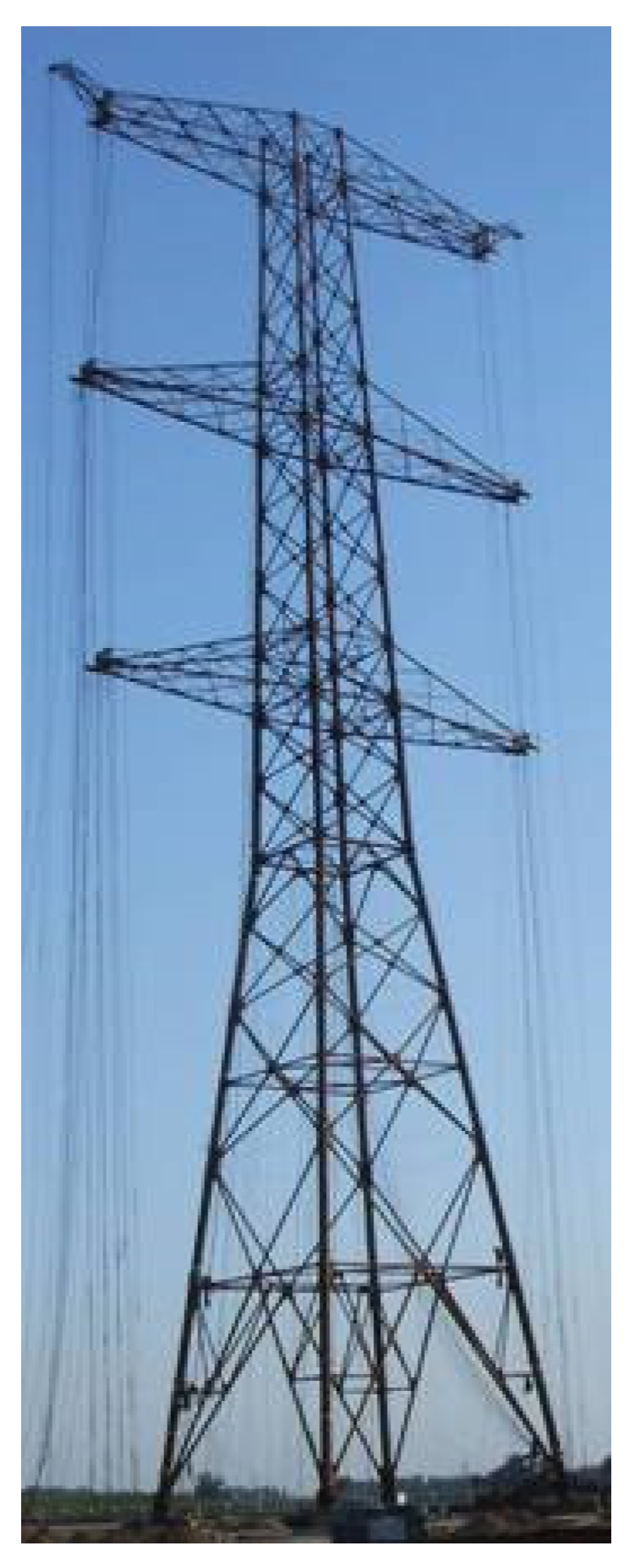
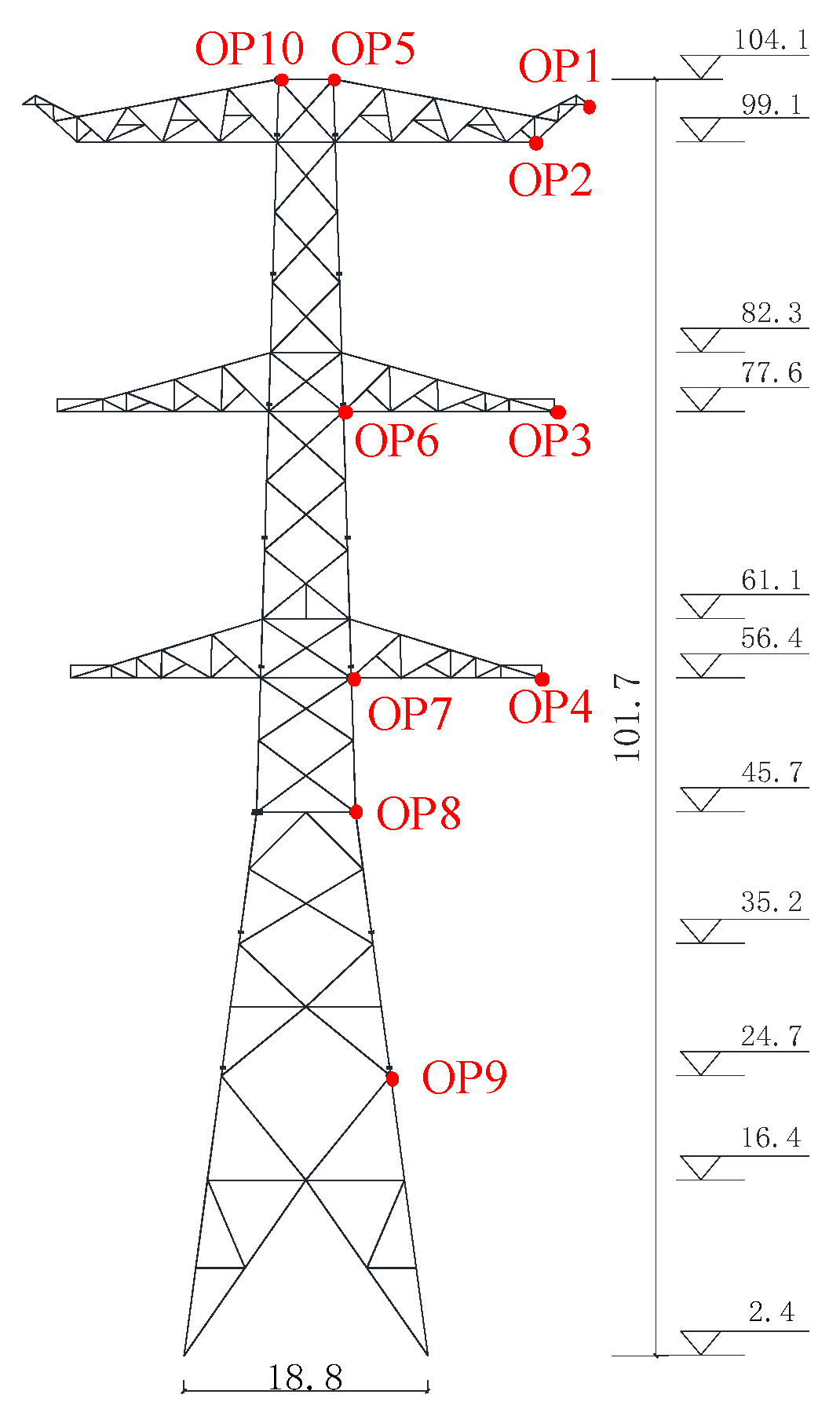

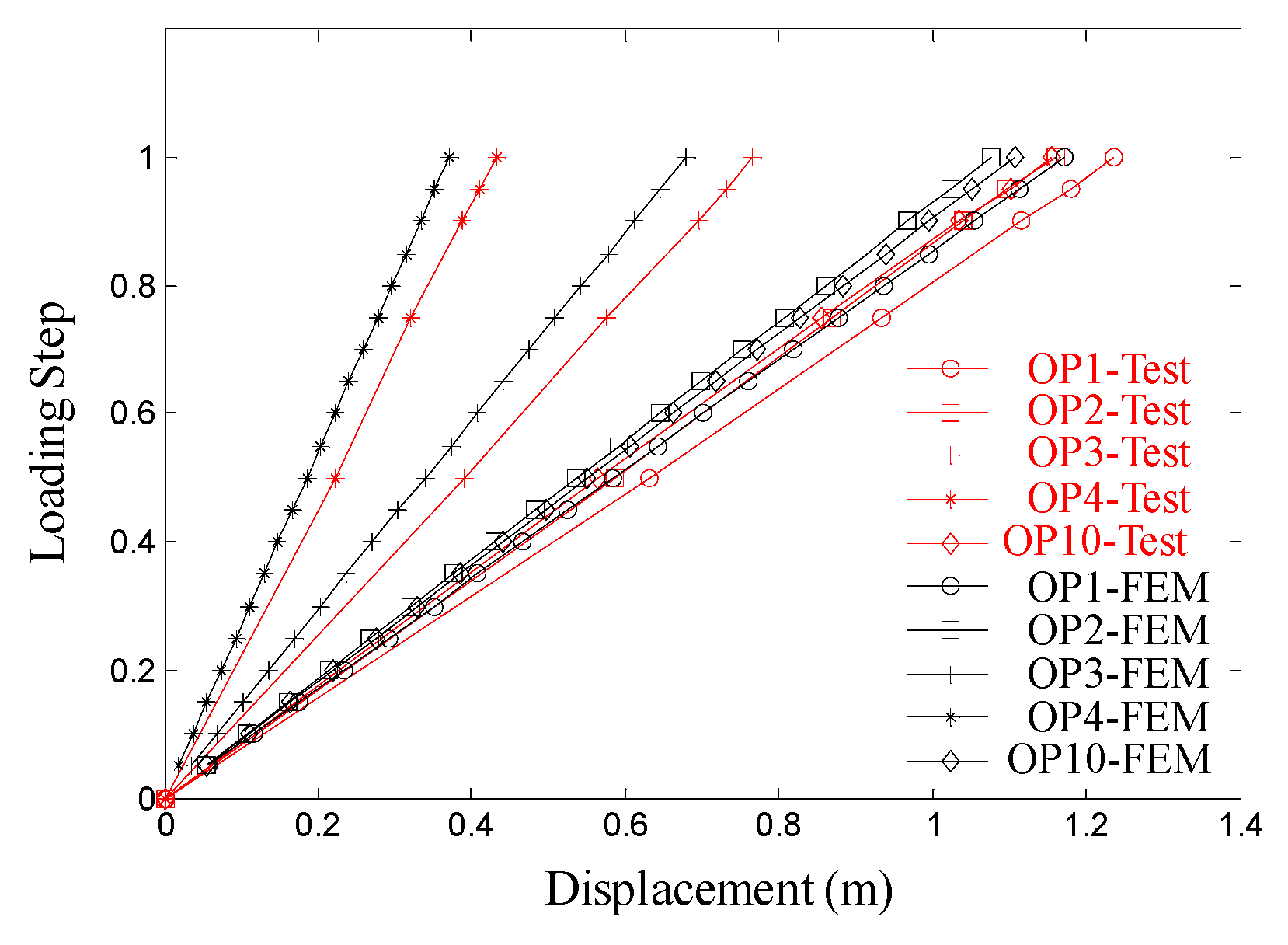
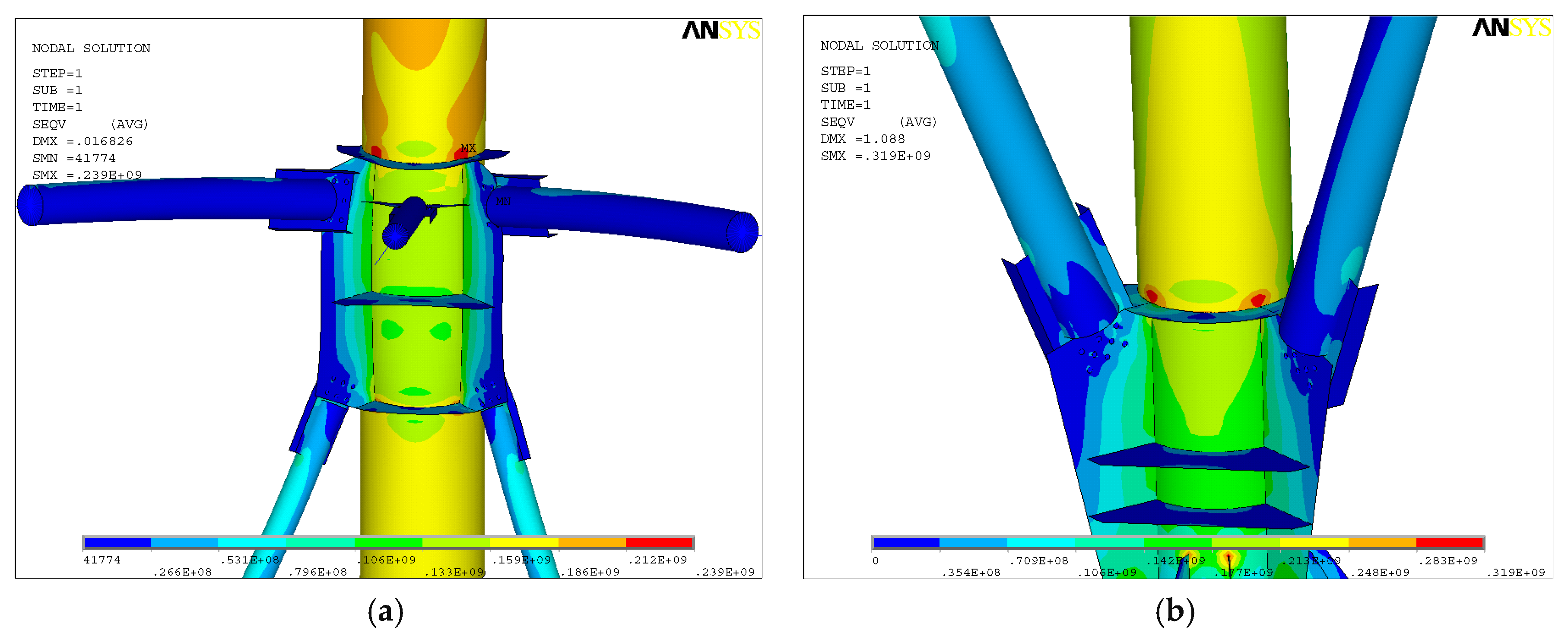
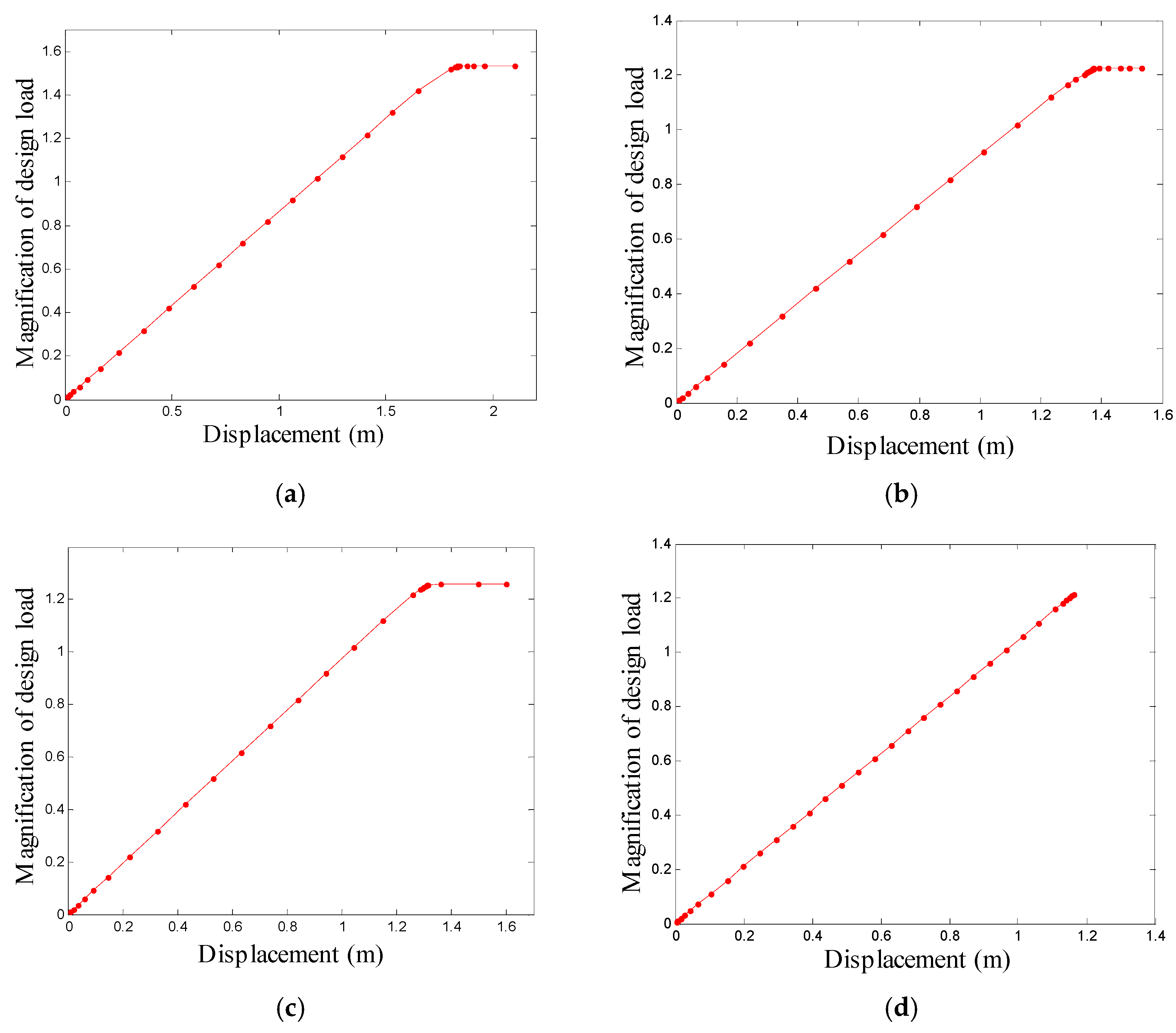

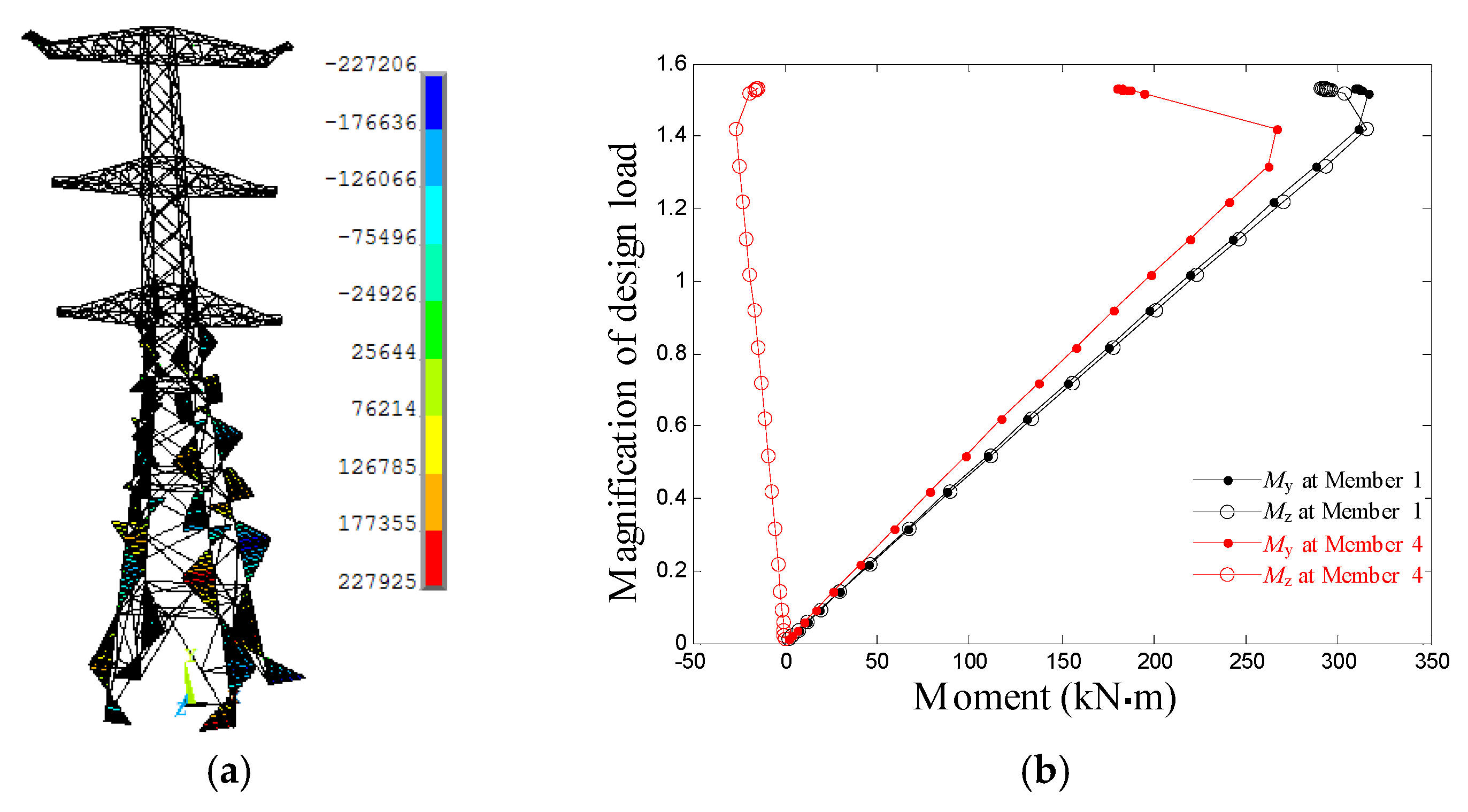
| Category | Connection between Tube and Joint Region | Cross Section | Total Number |
|---|---|---|---|
| Tower main body | U style | ∅102–∅273 | 22 |
| C style | ∅89–∅299 | 23 | |
| X style | ∅114–∅426 | 31 | |
| Diagonal material | U style | ∅102–∅426 | 34 |
| C style | ∅89–∅377 | 28 | |
| X style | ∅114–∅426 | 31 | |
| Accessory member | C style | ∅75–∅406 | 35 |
| Observation Point | 90-Degree Wind Load | 60-Degree Wind Load | ||||||
|---|---|---|---|---|---|---|---|---|
| FEA | Test | FEA | Test | |||||
| x Direction | z Direction | x Direction | z Direction | x Direction | z Direction | x Direction | z Direction | |
| 1 | 1146 | 473 | 1237 | 417 | 921 | 416 | 842 | 353 |
| 2 | 1008 | 380 | 1037 | 336 | 763 | 335 | 700 | 284 |
| 3 | 511 | 338 | 549 | 348 | 430 | 305 | 408 | 284 |
| 4 | 218 | 256 | 257 | 265 | 183 | 235 | 189 | 281 |
| 5 | 1005 | 46 | 1026 | 46 | 848 | 57 | 765 | 52 |
| 6 | 511 | 46 | 549 | 44 | 431 | 57 | 416 | 52 |
| 7 | 219 | 35 | 261 | 29 | 185 | 44 | 191 | 35 |
| 8 | 113 | 28 | 130 | 26 | 95 | 36 | 108 | 27 |
| 9 | 24 | 16 | 52 | 13 | 26 | 20 | 39 | 18 |
| 10 | 1102 | −34 | 1119 | −24 | 846 | −10 | 759 | −5 |
| Member Number | Design Load | Ultimate Load | Ratio (%) |
|---|---|---|---|
| 7330-7210 | −5449.5 | −8167.6 | 49.9 |
| 7210-7110 | −5464.5 | −8183.3 | 49.8 |
| 7110-7010 | −5503.2 | −8247.1 | 49.9 |
| 7010-2910 | −5792.6 | −8452.4 | 45.9 |
| 2910-2810 | −5536.7 | −8235.1 | 48.7 |
| 2810-2730 | −5542.6 | −8243.3 | 48.7 |
| 2730-2710 | −5711.5 | −8479.2 | 48.5 |
| 2710-2510 | −5722.4 | −8536.5 | 49.2 |
| 2510-2110 | −5205.6 | −7765.9 | 49.2 |
| 2110-1610 | −4641.7 | −6894.8 | 48.5 |
| Member Number | Design Load | Ultimate Load | Ratio (%) |
|---|---|---|---|
| 7330-7210 | −6912.2 | −8170.1 | 18.2 |
| 7210-7110 | −6929.2 | −8186.1 | 18.1 |
| 7110-7010 | −6984.1 | −8263.4 | 18.3 |
| 7010-2910 | −7334.1 | −8635.9 | 17.7 |
| 2910-2810 | −7015.0 | −8304.4 | 18.4 |
| 2810-2730 | −7022.2 | −8310.9 | 18.4 |
| 2730-2710 | −7245.6 | −8616.2 | 18.9 |
| 2710-2510 | −7276.0 | −8681.1 | 19.3 |
| 2510-2110 | −6618.6 | −7896.3 | 19.3 |
| 2110-1610 | −5883.0 | −7001.5 | 19.0 |
| Member Number | Design Load | Ultimate Load | Ratio (%) |
|---|---|---|---|
| 7330-7210 | −6774.5 | −8207.4 | 21.2 |
| 7210-7110 | −6791.5 | −8222.9 | 21.1 |
| 7110-7010 | −6845.2 | −8295.2 | 21.2 |
| 7010-2910 | −7180.0 | −8659.5 | 20.6 |
| 2910-2810 | −6859.1 | −8313.0 | 21.2 |
| 2810-2730 | −6866.2 | −8319.8 | 21.2 |
| 2730-2710 | −7073.6 | −8615.5 | 21.8 |
| 2710-2510 | −7093.8 | −8672.7 | 22.3 |
| 2510-2110 | −6457.8 | −7890.0 | 22.2 |
| 2110-1610 | −5732.2 | −6985.5 | 21.9 |
| Member Number | Design Load | Ultimate Load | Ratio (%) |
|---|---|---|---|
| 7330-7210 | −4625.6 | −5309.3 | 14.8 |
| 7210-7110 | −4638.6 | −5323.8 | 14.8 |
| 7110-7010 | −4661.2 | −5392.6 | 15.7 |
| 7010-2910 | −4905.8 | −5660.2 | 15.4 |
| 2910-2810 | −4674.6 | −5435.0 | 16.3 |
| 2810-2730 | −4680.0 | −5441.6 | 16.3 |
| 2730-2710 | −4816.1 | −5620.2 | 16.7 |
| 2710-2510 | −4833.1 | −5640.7 | 16.7 |
| 2510-2110 | −4405.6 | −5155.4 | 17.0 |
| 2110-1610 | −3910.8 | −4559.5 | 16.6 |
| Member Number | Axial Force /kN | Mxi /kN•m | Mxj /kN•m | Myi /kN•m | Myj /kN•m | Diameter /m | Thickness /m | Slenderness Ratio λ | Axial Stress /MPa | Strength Stress /MPa | Stability Stress /MPa | Maximum Stress/Axial Stress | Rod Length/ Diameter |
|---|---|---|---|---|---|---|---|---|---|---|---|---|---|
| 7330-7210 | −6912.16 | 279.04 | −233.44 | 281.60 | −243.86 | 0.66 | 0.014 | 38 | −243.40 | −351.95 | −364.65 | 1.50 | 13.09 |
| 7210-7110 | −6929.19 | −238.49 | −2.14 | −248.76 | 7.53 | 0.66 | 0.014 | 38 | −244.00 | −338.34 | −330.86 | 1.39 | 13.09 |
| 7110-7010 | −6984.13 | 3.61 | 152.42 | 11.80 | 77.04 | 0.63 | 0.014 | 33 | −257.91 | −306.96 | −312.42 | 1.21 | 11.29 |
| 7010-2910 | −7334.12 | 154.70 | −131.98 | 77.70 | −80.74 | 0.61 | 0.014 | 35 | −279.93 | −338.95 | −358.29 | 1.28 | 12.16 |
| 2910-2810 | −7015.04 | −87.85 | −133.89 | 104.36 | 82.06 | 0.61 | 0.014 | 27 | −267.75 | −322.03 | −306.77 | 1.20 | 9.16 |
| 2810-2730 | −7022.16 | −81.56 | 136.44 | −100.59 | 67.96 | 0.61 | 0.014 | 24 | −268.02 | −322.03 | −325.97 | 1.22 | 8.33 |
| 2730-2710 | −7245.55 | 136.89 | −67.65 | 68.93 | −36.80 | 0.61 | 0.014 | 29 | −276.55 | −348.72 | −333.86 | 1.26 | 10.00 |
| 2710-2510 | −7276.00 | −127.81 | −66.27 | 179.87 | 35.36 | 0.61 | 0.014 | 22 | −277.71 | −347.81 | −325.85 | 1.25 | 7.50 |
| 2510-2110 | −6618.62 | −118.43 | 64.65 | −177.88 | 58.58 | 0.61 | 0.014 | 27 | −252.62 | −320.13 | −320.08 | 1.27 | 9.35 |
| 2110-1610 | −5883.00 | 65.72 | −39.80 | 56.91 | −96.52 | 0.61 | 0.014 | 24 | −224.54 | −252.48 | −267.37 | 1.19 | 8.20 |
| Member Number | Axial Force /kN | Mxi /kN•m | Mxj /kN•m | Myi /kN•m | Myj /kN•m | Diameter /m | Thickness /m | Slenderness Ratio λ | Axial Stress /MPa | Strength Stress /MPa | Stability Stress /MPa | Maximum Stress/Axial Stress | Rod Length/ Diameter |
|---|---|---|---|---|---|---|---|---|---|---|---|---|---|
| 7330-7210 | −8170.10 | 292.31 | −253.46 | 292.25 | −262.17 | 0.66 | 0.014 | 38 | −243.40 | −400.88 | −418.88 | 1.72 | 13.09 |
| 7210-7110 | −8186.08 | −259.01 | 11.03 | −267.61 | 17.56 | 0.66 | 0.014 | 38 | −244.00 | −390.22 | −386.18 | 1.60 | 13.09 |
| 7110-7010 | −8263.36 | 16.55 | 110.81 | 21.80 | 52.68 | 0.63 | 0.014 | 33 | −257.91 | −339.74 | −356.38 | 1.38 | 11.29 |
| 7010-2910 | −8635.86 | 109.37 | −101.67 | 51.45 | −58.39 | 0.61 | 0.014 | 35 | −279.93 | −379.42 | −402.52 | 1.44 | 12.16 |
| 2910-2810 | −8304.37 | −89.28 | −104.45 | 109.24 | 59.76 | 0.61 | 0.014 | 27 | −267.75 | −365.65 | −357.98 | 1.37 | 9.16 |
| 2810-2730 | −8310.89 | −83.68 | 113.02 | −106.07 | 48.33 | 0.61 | 0.014 | 24 | −268.02 | −367.13 | −375.24 | 1.40 | 8.33 |
| 2730-2710 | −8616.23 | 110.92 | −57.29 | 48.67 | −6.38 | 0.61 | 0.014 | 29 | −276.55 | −371.79 | −383.21 | 1.39 | 10.00 |
| 2710-2510 | −8681.15 | −43.34 | −50.52 | 77.47 | −0.61 | 0.61 | 0.014 | 22 | −277.71 | −362.53 | −361.82 | 1.31 | 7.50 |
| 2510-2110 | −7896.29 | −37.98 | 65.54 | −86.37 | 35.03 | 0.61 | 0.014 | 27 | −252.62 | −336.00 | −349.99 | 1.39 | 9.35 |
| 2110-1610 | −7001.46 | 65.18 | −48.40 | 31.62 | −82.17 | 0.61 | 0.014 | 24 | −224.54 | −289.29 | −309.10 | 1.38 | 8.20 |
Disclaimer/Publisher’s Note: The statements, opinions and data contained in all publications are solely those of the individual author(s) and contributor(s) and not of MDPI and/or the editor(s). MDPI and/or the editor(s) disclaim responsibility for any injury to people or property resulting from any ideas, methods, instructions or products referred to in the content. |
© 2024 by the authors. Licensee MDPI, Basel, Switzerland. This article is an open access article distributed under the terms and conditions of the Creative Commons Attribution (CC BY) license (https://creativecommons.org/licenses/by/4.0/).
Share and Cite
Li, R.; Qi, L.; Dong, Y.-R.; Wang, H. Nonlinear Performance of Steel Tube Tower in Ultra-High Voltage Transmission Lines under Wind Loads. Buildings 2024, 14, 140. https://doi.org/10.3390/buildings14010140
Li R, Qi L, Dong Y-R, Wang H. Nonlinear Performance of Steel Tube Tower in Ultra-High Voltage Transmission Lines under Wind Loads. Buildings. 2024; 14(1):140. https://doi.org/10.3390/buildings14010140
Chicago/Turabian StyleLi, Ruiqi, Liangjie Qi, Yao-Rong Dong, and Hui Wang. 2024. "Nonlinear Performance of Steel Tube Tower in Ultra-High Voltage Transmission Lines under Wind Loads" Buildings 14, no. 1: 140. https://doi.org/10.3390/buildings14010140
APA StyleLi, R., Qi, L., Dong, Y.-R., & Wang, H. (2024). Nonlinear Performance of Steel Tube Tower in Ultra-High Voltage Transmission Lines under Wind Loads. Buildings, 14(1), 140. https://doi.org/10.3390/buildings14010140






